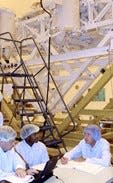Glen Rock-based former NASA engineer reflects on the Space Shuttle Columbia disaster
- Oops!Something went wrong.Please try again later.
With the 20th anniversary of the shuttle Columbia accident, I recall that fateful morning in 2003. I heard on the radio that Columbia and its crew had not been seen or heard from well after their scheduled landing time.
Back then, I was a NASA engineer at the Goddard Space Flight Center, and the Integration and Test Manager for Goddard's payload on that mission: "FREESTAR" was composed of a half-dozen science instruments, including the first Israeli shuttle experiment, MEIDEX, and the first Israeli astronaut, Ilan Ramon. I had worked with the crew before the mission and became close friends with the Israeli scientists. During a crew training visit to Goddard, I coordinated a dinner in Annapolis that we were honored to share with them. Ironically, as on the last Challenger flight, Columbia's crew was very diverse. Yet each had their own individual warmth that is hard to forget.
After hearing the news that February morning, I immediately drove down to Goddard's Payload Operations Control Center, hoping our ops team had received news that all was well. Sadly, it was clear to everyone that the shuttle and crew were indeed lost. The first thing that went through our minds was, "Could we have forgotten something? Did we screw up?" After a period of exchanging condolences (and hugs) with our Israeli friends, we began the solemn task of impounding documents and data.
Thus began a multi-month effort of identifying debris at the Kennedy Space Center, for which I led the FREESTAR team. It was rather sobering to see pieces of spaceflight hardware that one was used to handling in pristine cleanroom conditions sitting on the floor of a large hangar, singed almost beyond recognition. Our job as experts on the payload was to help identify every little piece to aid in the accident investigation. As is well-known now, debris from the shuttle's external tank impacted the left wing's leading edge that was designed to protect against the fiery heat of reentry.
While this damage was not known throughout the mission, some at Mission Control in Houston had concerns. One was a radar-detected object orbiting close to the shuttle on a parallel course. A couple of days after launch, our operations manager called me to ask whether a FREESTAR thermal blanket of the same size could have come off. I told her that physically that could not happen. Some in Houston had requested that the military take high-resolution photos of the orbiter. The Columbia Accident Investigation Board (CAIB) would later find that an STS-107 mission manager had rescinded that request, a fateful decision that may very well have changed history.
A positive story about STS-107 is less well known. FREESTAR was last in a series of payloads from Goddard's successful, low-cost "Hitchhiker" project that lasted over 17 years. Hitchhiker flew over five-dozen instruments, including ten ejectable satellites, making dozens of scientific discoveries and technology firsts. Despite its tragic demise, FREESTAR had its own list of accomplishments, many derived from data downlinked during the 15-day mission. But we also found enough payload hardware to help scientists piece-together some significant results, including:
• Discovering the synchronicity of lightning and observing lightning-induced "sprites";
• Correlating desert dust with cloud precipitation and terrestrial temperatures;
• Proving the theory that forest-fire smoke inhibits clouds and precipitation;
• Advancing climate-change science through solar irradiance observations;
• Developing high-resolution profiles of stratospheric ozone and desert aerosols;
• Investigating shear-thinning of atomic fluid, with technology transferable to a wide range of products;
• Conducting the first in-space demonstration of onboard navigation via GPS.
So, despite the STS-107 tragedy, Columbia and FREESTAR helped us to better understand nature and how we can improve technology for life on earth.
One significant finding of the CAIB was that many lessons from Challenger had not been learned. Although Columbia experienced a different failure mode, NASA managers again dismissed technical warning signs and advice from engineers that could have avoided an accident and saved lives. In her book, "The Challenger Launch Decision," sociologist Diane Vaughan called NASA's dismissal of repeated anomalies a "normalization of deviance." This seems to be a tragic flaw in our society in general, and maybe as a species: We don't seem to learn from history, and tend to ignore and even challenge expert advice on everything from health care to climate change. For the latter, we "normalize deviance" when it comes to how we live our lives, in areas like energy, transportation, food, and consumerism – all of which are unsustainable, that is, they will by definition end at some point, in a future that only we can decide.

I often think back on those days with a mix of sadness at the loss, nostalgia for Hitchhiker, and pride in what we had accomplished. But I feel mostly troubled: about what our high-carbon lifestyles holds for the future our planet. Will we heed earth's warning signs soon enough to avoid another, more far-reaching tragedy?
Michael Wright of Glen Rock, Pa. is a retired NASA engineer and a licensed social worker in Pennsylvania. He is also a freelance writer of national articles on the environment and climate change. For more information on the Columbia accident, and the Israeli astronaut Ilan Ramon, see "Space Shuttle Columbia: Mission of Hope" (PBS). For more information on NASA's Hitchhiker project, see Michael's chapter in "Space Exploration and Humanity: A Historical Encyclopedia" (ABC-CLIO).
This article originally appeared on York Daily Record: Glen Rock-based former NASA engineer reflects on the Columbia disaster
